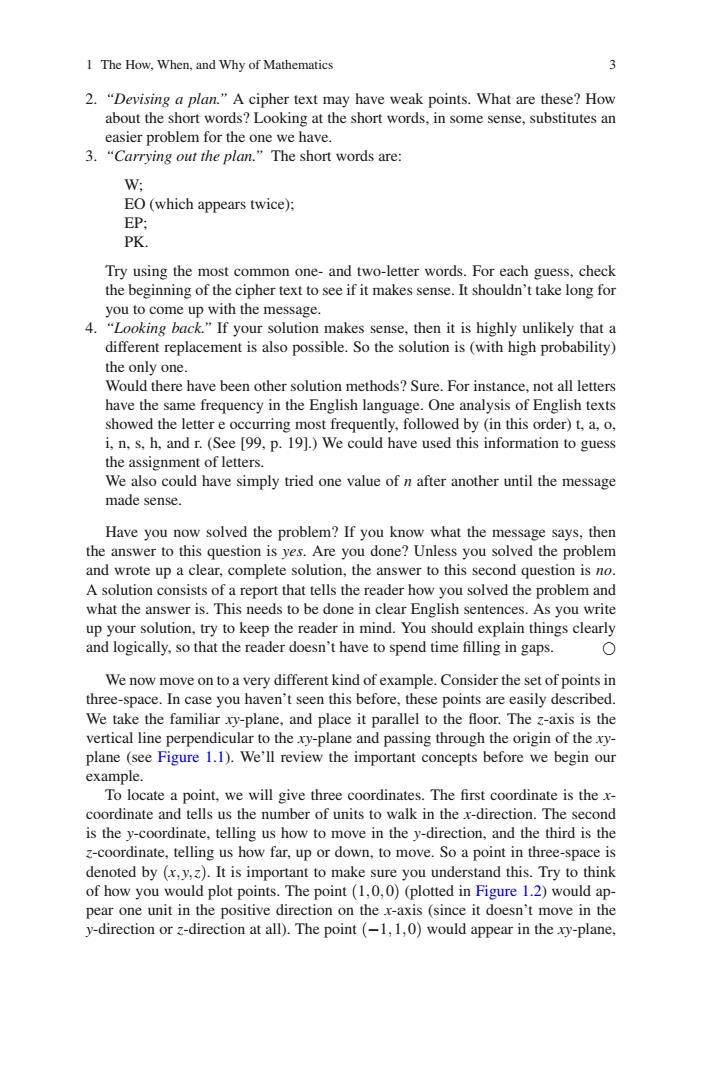正在加载图片...

I The How,When,and Why of Mathematics 3 2."Devising a plan."A cipher text may have weak points.What are these?How about the short words?Looking at the short words,in some sense,substitutes an easier problem for the one we have. 3.“Carrying out the plan.”The short words are: W: EO(which appears twice): EP; PK. Try using the most common one-and two-letter words.For each guess,check the beginning of the cipher text to see if it makes sense.It shouldn't take long for you to come up with the message. 4."Looking back."If your solution makes sense,then it is highly unlikely that a different replacement is also possible.So the solution is (with high probability) the only one. Would there have been other solution methods?Sure.For instance,not all letters have the same frequency in the English language.One analysis of English texts showed the letter e occurring most frequently,followed by (in this order)t,a,o, i,n,s,h,and r.(See [99,p.19].)We could have used this information to guess the assignment of letters. We also could have simply tried one value of n after another until the message made sense. Have you now solved the problem?If you know what the message says,then the answer to this question is yes.Are you done?Unless you solved the problem and wrote up a clear,complete solution,the answer to this second question is no. A solution consists of a report that tells the reader how you solved the problem and what the answer is.This needs to be done in clear English sentences.As you write up your solution,try to keep the reader in mind.You should explain things clearly and logically,so that the reader doesn't have to spend time filling in gaps. ○ We now move on to a very different kind of example.Consider the set of points in three-space.In case you haven't seen this before,these points are easily described. We take the familiar xy-plane,and place it parallel to the floor.The z-axis is the vertical line perpendicular to the xy-plane and passing through the origin of the xy- plane (see Figure 1.1).We'll review the important concepts before we begin our example. To locate a point,we will give three coordinates.The first coordinate is the x- coordinate and tells us the number of units to walk in the x-direction.The second is the y-coordinate,telling us how to move in the y-direction,and the third is the z-coordinate,telling us how far,up or down,to move.So a point in three-space is denoted by (x,y,)It is important to make sure you understand this.Try to think of how you would plot points.The point (1,0,0)(plotted in Figure 1.2)would ap- pear one unit in the positive direction on the x-axis (since it doesn't move in the y-direction or z-direction at all).The point (-1,1,0)would appear in the xy-plane,1 The How, When, and Why of Mathematics 3 2. “Devising a plan.” A cipher text may have weak points. What are these? How about the short words? Looking at the short words, in some sense, substitutes an easier problem for the one we have. 3. “Carrying out the plan.” The short words are: W; EO (which appears twice); EP; PK. Try using the most common one- and two-letter words. For each guess, check the beginning of the cipher text to see if it makes sense. It shouldn’t take long for you to come up with the message. 4. “Looking back.” If your solution makes sense, then it is highly unlikely that a different replacement is also possible. So the solution is (with high probability) the only one. Would there have been other solution methods? Sure. For instance, not all letters have the same frequency in the English language. One analysis of English texts showed the letter e occurring most frequently, followed by (in this order) t, a, o, i, n, s, h, and r. (See [99, p. 19].) We could have used this information to guess the assignment of letters. We also could have simply tried one value of n after another until the message made sense. Have you now solved the problem? If you know what the message says, then the answer to this question is yes. Are you done? Unless you solved the problem and wrote up a clear, complete solution, the answer to this second question is no. A solution consists of a report that tells the reader how you solved the problem and what the answer is. This needs to be done in clear English sentences. As you write up your solution, try to keep the reader in mind. You should explain things clearly and logically, so that the reader doesn’t have to spend time filling in gaps. We now move on to a very different kind of example. Consider the set of points in three-space. In case you haven’t seen this before, these points are easily described. We take the familiar xy-plane, and place it parallel to the floor. The z-axis is the vertical line perpendicular to the xy-plane and passing through the origin of the xyplane (see Figure 1.1). We’ll review the important concepts before we begin our example. To locate a point, we will give three coordinates. The first coordinate is the xcoordinate and tells us the number of units to walk in the x-direction. The second is the y-coordinate, telling us how to move in the y-direction, and the third is the z-coordinate, telling us how far, up or down, to move. So a point in three-space is denoted by (x, y,z). It is important to make sure you understand this. Try to think of how you would plot points. The point (1,0,0) (plotted in Figure 1.2) would appear one unit in the positive direction on the x-axis (since it doesn’t move in the y-direction or z-direction at all). The point (−1,1,0) would appear in the xy-plane